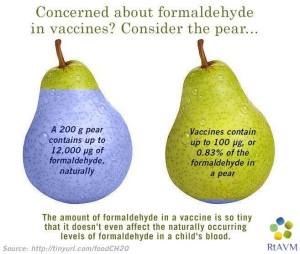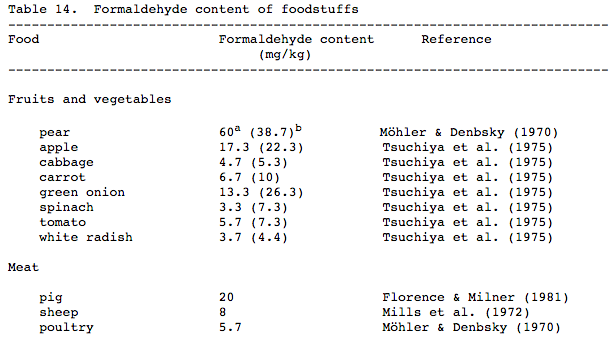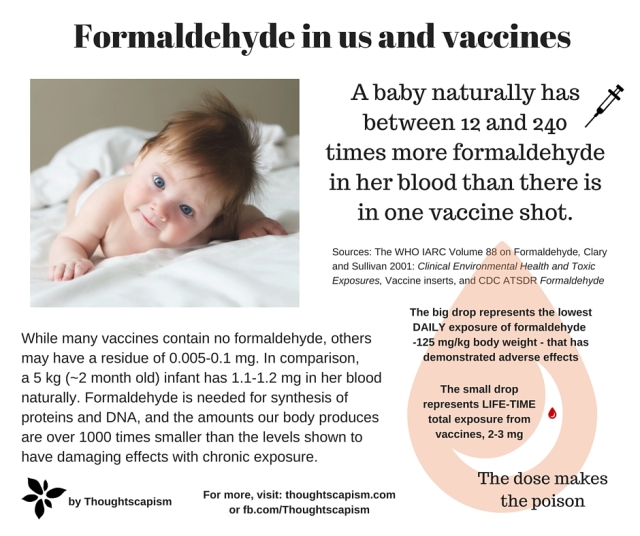Bathing in a solution of formaldehyde would probably be bad for you, seeing as formaldehyde is classified as a human carcinogen – at least “under conditions of unusually high or prolonged exposure”, as reported by Cancer.gov formaldehyde fact sheet. And even low levels of formaldehyde in the air can result in a burning sensation in the airways and skin irritation – in fact inhalation is the most harmful route of exposure. From the FDA:
the highest risk is from the air when formaldehyde is inhaled from breathing, and occurs more frequently in people who routinely use formaldehyde in their jobs.
So people working with formaldehyde should be careful with how they handle it – like I used to do, when working with fixating cell samples for microscopy. But then again, formaldehyde on low levels in our cells is quite a different matter. It is necessary for the biosynthesis of amino acids, proteins, and nucleic acids (DNA). What levels are we talking about when it comes to vaccines? Even at maximum residue levels, less than one tenth of what is found in the blood volume of a baby.
There are several people that have already made thorough summaries about formaldehyde in vaccines with meticulous references to scientific literature and research, that you should really read if you’d like to go more in depth. Like this one, from an infectious disease researcher and mom, with the blog Just the Vax:
Formaldehyde is a normal, essential human metabolite with a biological half-life of about 1.5 minutes (Clary and Sullivan 2001). It is endogenously produced and is involved with methylation reactions for and biosynthesis of some proteins and nucleic acids. It is also rapidly metabolised to formate and excreted in urine or to carbon dioxide and exhaled (WHO, 2006 and Clary and Sullivan 2001).
Another thorough look comes from the medicine, ethics, and health care blog Harpocrates speaks, in their piece Demystifying vaccine ingredients – Formaldehyde:
So what’s the most a child might get in a single office visit? That would probably be at their 6 month visit (when they are, on average, 16.5lbs or 7.5kg) with HepB, DTaP, IPV and flu, for a total of 307.5μg. That is about 160 times less than the total amount their body naturally produces every single day. Compare that to the 428.4-1,516.4μg of formaldehyde in a single apple.
From the basic scientific course literature (Clary and Sullivan 2001 Clinical Environmental Health and Toxic Exposures), we can learn about the quite impressive ubiquitous handling of formaldehyde going on at all times inside ourselves:
The body normally produces and metabolizes (detoxifies and uses) 50,000 mg of endogenous formaldehyde daily. It has been calculates that an adult human liver will metabolize 22 mg of formaldehyde per minute (or 1,320 mg per hour).
This topic has also been covered well in The Conversation, in two articles by Ian Musgrave, a Senior lecturer in Pharmacology at University of Adelaide, Toxins’ in vaccines: a potentially deadly misunderstanding and Vaccines and toxins – more misunderstanding:
The levels of formaldehyde in our blood are over 1,000 times less than the levels shown to have damaging effects when taken chronically, so increasing the normal blood levels by 10% (the sort of fluctuation you would see day to day anyway) for less than a day will not do any harm.
There is absolutely no evidence of harm from the formaldehyde in vaccines. Not for cancer (from the FDA):
There is no evidence linking cancer to infrequent exposure to tiny amounts of formaldehyde via injection as occurs with vaccines.
Nor anything else – from the review article: Addressing Parents’ Concerns: Do Vaccines Contain Harmful Preservatives, Adjuvants, Additives, or Residuals?:
quantities of mercury, aluminum, formaldehyde, human serum albumin, antibiotics, and yeast proteins in vaccines have not been found to be harmful in humans or experimental animals.

By Refutations to Anti Vaccine Memes and Tara Haelle, source of values here
Looking at the amounts of formaldehyde we are talking about in vaccines, this is hardly surprising. Even the vaccines with the largest residues of formaldehyde deliver an amount that is fully within the normal fluctuations of the level of formaldehyde in the blood.
For more perspectives on the levels of formaldehyde that are harmless on day-to-day basis, here a couple of looks at levels in food – and formaldehyde is almost completely absorbed from the oral tracts. From Refutations to Anti Vaccine Memes:
And another table of common foodstuffs and their formaldehyde content in mg/kg, here:

See the whole table
If somebody is trying to make you scared of formaldehyde in vaccines, they are disregarding a body of evidence showing the contrary. That is not a encouraging starting point for a rational discussion, but then, scaring parents about vaccine ingredients rarely relies on rational arguments – it is an attempt to make our emotions overrule the use of reason.
For more scare stories about vaccine ingredients you can also read: Mercury in retrogade and Aluminum in perspective.
More references
For a more thorough overview about the sources behind the infographic, please see detailed sources and quotes here:
To begin with, Just the Vax gives a good summary of some basic figures to work with (emphasis mine):
Human normal blood concentrations of formaldehyde are 2.74 +/- 0.14 mg/L (Franks 2005). The average adult male (86 kg) in the U.S. has a blood volume of 5.8 litres; the average adult female (74 kg) has a blood volume of 5.0 litres and an average 2 month old infant (5 kg), 0.43 litres. So this translates to 15.1-16.7 mg of normal formaldehyde range in an adult male, 13.0-14.4 mg in an adult female and 1.1-1.2 mg in a 2 month-old infant which works out to be 0.22-0.24 mg/kg (CHOP 2008 and Franks 2005).
Harpocrates speaks has compiled a table with all the formaldehyde levels in different vaccines from the information in their vaccine inserts – what a huge effort. Thanks! Check out the table in his piece for all of them. This is his summary of the maximum amounts in regular childhood vaccines:
Note, not all of these are actually required for school entry and lower formaldehyde content vaccines are available for most of these:
-
HepB – Recombivax – 3 doses (birth, 1-2 mos. and 6-18 mos.) – 7.5μg/dose
-
DTaP – Infanrix – 5 doses (2 mos., 4 mos., 6 mos., 15-18 mos. and 4-6 yrs.) – 100μg/dose
-
Hib – ActHIB – 3 doses (2 mos., 4 mos. and 12-15 mos.) – 0.5μg/dose
-
IPV – IPOL – 4 doses (2 mos., 4 mos., 6-18 mos. and 4-6 yrs.) – 100μg/dose
-
Influenza – Fluzone – 7 doses (6 mos., 12 mos. and yearly 2-6 yrs.) – 100μg/dose
-
HepA – Havrix – 2 doses (12 mos. and 6-18 mos. after first dose) – 100μg/dose
Using their sources, I find babies having a factor 12-240 more formaldehyde in their blood (1.2mg) than the typical childhood vaccine dose (0.005-0.1 mg – comparing to the vaccines of each kind with the largest formaldehyde residue, and completely disregarding Hib vaccine which has even less, maximum 0.0005 mg). The FDA also make a specific estimate of newborn vaccines (Hep B) where the amount of formaldehyde is among the lowest – the natural amount in blood being larger by a factor 50-70.
Studies have shown that for a newborn of average weight of 6 – 8 pounds, the amount of formaldehyde in their body is 50-70 times higher than the upper amount that they could receive from a single dose of a vaccine or from vaccines administered over time.
Excerpts from additional sources: the WHO IARC (World Health Organisation, International Agency for Research for Cancer) volume 88 on Formaldehyde:
It is an essential intermediate in the biosynthesis of purines, thymidine and certain amino acids (Neuberger, 1981).
…
The endogenous concentration of formaldehyde, determined by GC–MS (Heck et al., 1982), in the blood of human subjects not exposed to formaldehyde was 2.61 ± 0.14 μg/g blood (mean ± standard error [SE]; range, 2.05–3.09 μg/g) (Heck et al., 1985), i.e. about 0.1 mmol/L (assuming that 90% of the blood volume is water and the density of human blood is 1.06 g/cm3 (Smith et al., 1983)). This concentration represents the total concentration of both free and reversibly bound endogenous formaldehyde in the blood.…
Formaldehyde is absorbed rapidly and almost completely from the rodent intestinal tract (Buss et al., 1964).
Here is the CDC ATSDR (Center for Disease Control, Agency for Toxic Substances and Disease Registry) overview on formaldehyde, including data on MRL (Minimum Risk Levels), NOAL (No Observed Adverse Effects Level), and LOAEL (Lowest Observed Adverse Effect Level). Emphasis mine:
Increased incidence of hepatocellular vacuolization was found in rats exposed to gavage dose level of 80 mg/kg/day for 4 weeks (Vargova et al. 1993), but other studies found no exposure-related changes in liver weight or histopathology in rats exposed to drinking-water doses as high as 150 mg/kg/day for 90 days (Johannsen et al. 1986), 125 mg/kg/day for 4 weeks (Til et al. 1988b), 82–109 mg/kg/day for 2 years (Til et al. 1989), and 300 mg/kg/day for 2 years (Tobe et al. 1989). Liver weight and histopathology were likewise unaffected in Beagle dogs exposed to up to 100 mg/kg/day in the diet for 90 days (Johannsen et al. 1986), as were serum enzyme activities indicative of liver damage in rats exposed to up to 300 mg/kg/day for up to 2 years (Tobe et al. 1989).
An MRL of 0.3 mg/kg/day has been derived for intermediate-duration oral exposure (15–364 days) to formaldehyde. The MRL was based on a NOAEL of 25 mg/kg/day for gastrointestinal effects in rats exposed to formaldehyde in drinking water (Til et al. 1988b). The LOAEL was 125 mg/kg/day.
For your convenience, here also the links to some references used by Just the vax. A paywalled article, Franks 2005: http://www.sciencedirect.com/science/article/pii/S0041008X04005368
and the Clary and Sullivan 2001 basic scientific literature piece once more: Clinical Environmental Health and Toxic Exposures. Additional quote:
Formaldehyde is absorbed readily from the respiratory and oral tracts and, to a much lesser degree, from the skin.
The graphical details: the calculations for big and small drop are based on calculation from Harpocrates speaks, 1.8 mg of formaldehyde by 6 years old if the vaccines used were the ones with most formaldehyde residue.
That’s all of the vaccines on the recommended schedule for 0-6 years that contain formaldehyde. If a child got all of those doses all at once (which they never would), they would get a total of 1,824μg, or 1.824mg, of formaldehyde.
After that age, having the maximum of 7 vaccines included in US schedule (about 0.1+0.003+0.003+0.1+0+0+0 = 0.2006 mg) arrives us at 2 mg. Taking additional flu shots into account – there are some 13 different flu shots listed in the Harpocrates speaks summary, only 3 of them have 0.1-0.2 mg of formaldehyde, and the other 10 vary from 0-0.025 mg. Your average Trivalent Influenza vaccine would have 0.028 mg of formaldehyde, and calcucalted with that one could take 35 additional flu shots and not still not quite reach the life-time sum of 3 mg. Alternatively, always using one of the Trivalent flu vaccines with no formaldehyde, life-time exposure would remain at 2 mg no matter the number of flu shots. Important part is that neither choice would bring anything close to harmful levels of formaldehyde (which would be about 7,500-11,250 mg per day over a longer period for an adult).
The size relation of the droplets
3 mg life-time total vs
the CDC LOAEL (Lowest Observed Adverse Effect Level): 125 mg/kg/day
Body weight obviously varies over the course of lifetime. To be on the safe side, it was calculated for 10 and 20 kg toddler/child sized body.
125 mg/kg/day * 10 kg = 1250 mg/day
125 mg/kg/day * 20 kg = 2500 mg/day
Relation:
1250 mg/ 3 mg = 416. 67 or 2500 mg / 3 mg = 833.33
To represent the relation in the form of area, the length of the sides scale as follows: small drop side length is: (square root of relation) * the side length of the big drop. Big drop side lenght being at 400 pixels, the small drop side lenght should range between (depending if calculating with weight 10 or 20 kg) 14 and 20 pixels. Set at 17 pixels (a pixel is at the scale of a millimeter or less). For 60 kg adult that would be at 8 pixels.




Pingback: Aluminum in perspective | Thoughtscapism
Is the formaldehyde in vaccines chemically/biologically identical to the formaldehyde produced in the body?
LikeLike
Couple things about formaldehyde. It is not an ionic substance and so, basically, if it’s bound to something else, it’s covalently bound which means it’s no longer formaldehyde and if it isn’t bound then it is just that: unbound. (I purposefully excluded formalin because it’s just dissolved formaldehyde — hydrogen bonds.) Formaldehyde is achiral which means there are no L/D or S/R enantiomers which further means there are no variations in biological activity owing to the arrangement of the molecule itself. Formaldehyde is formaldehyde.
LikeLike
I found this article on formaldehyde metabolism very “fruitful”!
http://onlinelibrary.wiley.com/doi/10.2903/j.efsa.2014.3550/pdf
LikeLike
Pingback: 5 chemicals you probably don’t need to worry so much about – krisnoble.co.uk
Thank you. Trying to convince my daughter how important it is to vaccinate her child. Explaining how formaldehyde, the good, the bad and the ugly. Peace Beth
LikeLike